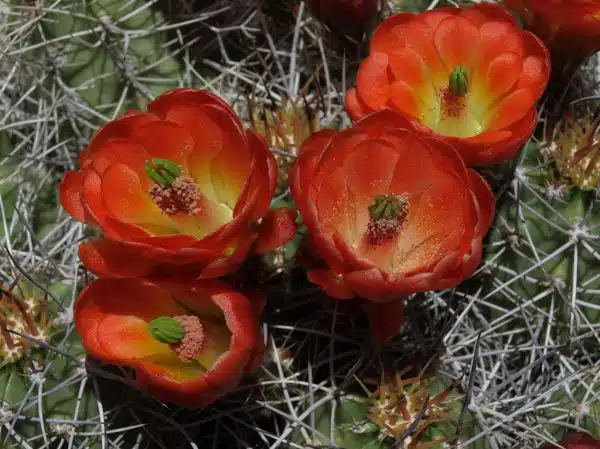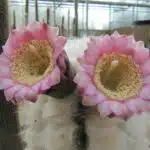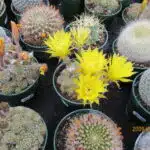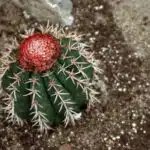Echinocereus cactus is a remarkable plant commonly found in the arid regions of the Americas. This cactus species has gained popularity among garden enthusiasts and landscapers because of its striking beauty, easy-care requirements, and ability to thrive in harsh environments. However, growing and caring for Echinocereus cactus can be a daunting task for beginners, as it requires specific conditions to flourish.
This article aims to provide a comprehensive guide on how to grow and care for Echinocereus cactus. From choosing the right soil mix to watering techniques, this guide will equip you with all the essential information needed to help your Echinocereus cactus thrive. Whether you are a seasoned gardener or just starting, this guide will help you create an enchanting landscape filled with beautiful and healthy Echinocereus cacti.
Understanding The Echinocereus Cactus
If you’re looking for a plant that’s easy to care for and adds a touch of southwestern flair to your home, the echinocereus cactus is an excellent choice. This hardy plant can survive in a variety of climates, from hot and dry deserts to cooler mountain regions. But before you start growing your own echinocereus, it’s important to understand its anatomy and habitat.
The echinocereus cactus is a member of the Cactaceae family, which includes more than 2,000 species of succulents. This particular cactus grows in clusters or solitary stems that can reach up to 3 feet tall. Its stem is ribbed and covered in spines, which can range in color from white to brown or black. The flowers of the echinocereus are typically brightly colored and bloom in spring or summer.
In its natural habitat, the echinocereus cactus is found throughout North and South America. It thrives in rocky areas with well-draining soil, such as mountainsides and desert slopes. Some varieties can also be found growing on cliffs or even hanging from trees! Understanding its native environment will help you better care for this unique plant as you bring it into your home or garden.
As you embark on your journey to grow an echinocereus cactus, it’s important to keep in mind that choosing the right soil mix will be crucial to its success. In the next section, we’ll explore what kind of soil works best for this hardy plant so that you can provide it with the optimal environment it needs to thrive.
Choosing The Right Soil Mix
When it comes to selecting soil for your echinocereus cactus, the right composition is essential. These plants require a well-draining soil that is rich in nutrients and minerals. A good mix should consist of equal parts sand, perlite, and peat moss. The sand will help with drainage, while the perlite provides aeration and the peat moss retains moisture.
It’s also important to consider pot size when choosing soil mix. Echinocereus cacti prefer tight quarters, so it’s best to choose a pot that is just slightly larger than the plant’s root ball. This will help prevent overwatering and ensure that the soil remains dry enough for optimal growth.
Overall, selecting the right soil composition and pot size can greatly impact the health and growth of your echinocereus cactus. By following these guidelines, you’ll be able to provide your plant with an environment in which it can thrive. In order to further ensure optimal growth, it’s important to also provide adequate drainage for excess water – this will be discussed in the subsequent section.
Providing Adequate Drainage
After selecting the right soil mix for your echinocereus cactus, it’s important to choose an appropriate container that will allow for adequate drainage. There are a variety of container options available, including clay pots and plastic containers with drainage holes at the bottom. It’s important to avoid containers without drainage holes, as excess water can lead to root rot.
Root rot prevention is crucial for the health of your echinocereus cactus. To ensure proper drainage, consider adding a layer of rocks or pebbles at the bottom of your container before adding soil. This will create a space for excess water to drain out and prevent the soil from becoming too saturated.
In addition to using proper container options and preventing root rot, watering techniques and frequency are also critical factors in caring for your echinocereus cactus. In the next section, we’ll discuss how often you should water your cactus and provide tips on how to properly water it to ensure its continued growth and health.
Watering Techniques And Frequency
One of the most crucial aspects of caring for echinocereus cactus is proper watering. Overwatering or underwatering can lead to various problems such as root rot, yellowing of leaves, and wilting. The frequency of watering your echinocereus cactus depends on several factors such as the type of soil mix, humidity levels, and temperature.
To determine the watering frequency for your echinocereus cactus, it’s essential to check the soil moisture retention regularly. Stick your finger about an inch into the soil; if it feels dry, it’s time to water. However, if the soil feels moist or wet, don’t water yet as overwatering can cause more harm than good. It’s also important to note that different types of echinocereus cacti have varying water requirements.
When watering your echinocereus cactus, avoid getting water on its body as this can lead to sunburn or fungal infections. Instead, use a watering can with a narrow spout or a spray bottle to apply water directly onto the soil. Allow the soil to absorb water thoroughly before draining excess water from the saucer.
- Achieving perfect moisture balance in your echinocereus cactus can be quite satisfying.
- The sight of healthy new growth after a period of proper watering is incredibly gratifying.
- Overwatering your plant may result in stunted growth and even death.
- Underwatered cacti will look shriveled and wilted.
- Consistency in adhering to proper watering techniques leads to healthy plants and beautiful blooms.
Next up: Fertilizing Your Echinocereus Cactus
Fertilizing Your Echinocereus Cactus
Fertilizing your echinocereus cactus is key to ensuring its optimal growth and health. When it comes to choosing a fertilizer, there are two main types: organic and synthetic. Organic fertilizers are made from natural materials such as bone meal, blood meal, and composted manure. They release nutrients slowly over time as they break down in the soil. Synthetic fertilizers, on the other hand, are made from chemical compounds and provide an immediate nutrient boost to plants.
While both types of fertilizers can be used on echinocereus cacti, organic fertilizers are generally preferred for their slow-release properties and for being environmentally friendly. Synthetic fertilizers can cause soil acidification over time and may contain harmful chemicals that can negatively impact the plant’s health. It’s important to note that when using any type of fertilizer, it’s crucial to follow the instructions carefully and not over-fertilize as this can harm the plant.
The best time to fertilize your echinocereus cactus is during its active growing season, which typically occurs in spring and summer months. During this time, the plant will be more receptive to nutrients due to its increased metabolic activity. It’s recommended to apply a balanced fertilizer with equal amounts of nitrogen, phosphorus, and potassium every two weeks during this period. However, during winter months when the plant is dormant or semi-dormant, it’s best to avoid fertilizing altogether as this may cause damage or stress to the plant.
With proper fertilization practices in place using organic or synthetic methods at appropriate times throughout the year, your echinocereus cactus will thrive with healthy growth patterns and a prolonged lifespan. The next step in maintaining your cactus is understanding its sunlight requirements which we will delve into in further detail below.
Sunlight Requirements
Picture yourself walking through a desert landscape, where the sun is beating down on you relentlessly. This might be what comes to mind when you think of the echinocereus cactus, and it’s not too far from reality. These cacti thrive in areas with abundant sunlight exposure, making them perfect for those living in regions with high light intensity.
Sunlight exposure is crucial to the growth and health of your echinocereus cactus. Ideally, these plants should receive at least six hours of direct sunlight every day. This can be achieved by placing them near south-facing windows or outdoors in an area that receives ample sunshine. If you live in a region with harsh summers, consider providing some shade during peak hours to prevent scorching.
When it comes to light intensity, echinocereus cacti are quite adaptable. While they prefer direct sunlight, they can also tolerate partial shade. Additionally, these plants are capable of thriving under artificial light sources such as fluorescent bulbs or LED lights. However, keep in mind that natural sunlight is always best for their overall health and growth.
As important as sunlight exposure is to your echinocereus cactus, it’s not the only environmental factor to consider. Temperature and humidity also play significant roles in their well-being. In the next section, we’ll discuss how to ensure that your plant stays comfortable and healthy by taking these factors into account.
Temperature And Humidity Considerations
The amount of sunlight the echinocereus cactus receives is not the only factor that affects its growth. Temperature regulation and humidity control are also important considerations when it comes to caring for this type of cactus. Echinocereus cacti are native to hot, arid regions, which means they require warm temperatures and low humidity levels to thrive.
To keep your echinocereus cactus healthy, it’s essential to maintain a consistent temperature range between 65°F and 85°F (18°C-29°C). Extreme fluctuations in temperature can cause damage to the plant, so it’s crucial to avoid exposing it to sudden changes in temperature. Consider placing your cactus in a spot that is sheltered from drafts, such as near a window with indirect sunlight or under a patio shade.
In addition to regulating the temperature around your echinocereus cactus, you should also pay attention to the humidity levels in its environment. These types of cacti prefer low humidity levels between 10% and 30%. To achieve this level of humidity, you may need to use a dehumidifier or air conditioner if you live in an area with high humidity. By controlling the temperature and humidity around your echinocereus cactus, you can help ensure its healthy growth and longevity.
Moving on from temperature and humidity considerations for growing echinocereus cacti, let’s now explore pruning and propagation tips for these unique plants.
Pruning And Propagation Tips
Pruning is an essential aspect of maintaining the growth and health of your echinocereus cactus. The ideal time to prune your cactus is during the growing season, which is typically in the summer months. Pruning helps to remove dead or damaged stems, promote air circulation, and prevent disease. It also encourages new growth and ensures that your cactus maintains its shape.
To prune your echinocereus cactus effectively, you will need a set of pruning tools such as sharp shears or scissors. Before you begin pruning, sterilize your tools with rubbing alcohol to prevent the spread of diseases from one plant to another. Always wear gloves to protect yourself from the spines on the cactus stem. Make clean cuts at a 45-degree angle just above a node or joint where new growth can emerge.
Propagation methods for echinocereus cactus include seed propagation and stem cuttings. Seed propagation involves planting seeds in well-draining soil mixtures and keeping them moist until germination occurs. Stem cuttings propagation involves cutting a healthy stem at least four inches long and allowing it to dry for a few days before planting it in well-draining soil mixtures. Both methods require patience, proper care, and attention to detail for success.
Moving forward, knowing how to prune and propagate your echinocereus cactus effectively will help keep it healthy and thriving for years to come. In the next section, we will discuss pests and diseases that you should watch out for when caring for your echinocereus cactus.
Pests And Diseases To Watch Out For
Despite echinocereus cactus being hardy plants, they are not immune to pests and diseases. As a responsible plant owner, it is important to be aware of the common pests and diseases that can affect your echinocereus cactus. Prevention is always better than cure, so it is essential to take precautions to protect your plant against these issues.
One of the most common pests that can affect echinocereus cactus is mealybugs. These small, white insects feed on the sap of the plant and can cause wilting, yellowing or browning of leaves. To prevent mealybugs from infesting your plant, make sure you keep your cactus clean and dry. If you do spot any signs of mealybugs, remove them immediately with a soft brush or cotton swab dipped in alcohol.
Disease prevention is also crucial for maintaining the health of your echinocereus cactus. One disease that can affect this type of cactus is root rot. Overwatering or poor drainage can lead to root rot, which causes the roots to decay and turn brown. To prevent this issue, make sure you allow the soil to dry out between waterings and ensure that the pot has good drainage. Regularly inspect your plant for any signs of discoloration or wilting, as these could be early indicators of root rot.
Now that you know how to protect your echinocereus cactus from common pests and diseases through preventative measures, it’s time to focus on displaying it with style. By incorporating different textures and colors into your display, you can create a visually appealing arrangement that showcases the beauty of this unique plant species. Stay tuned for our next section where we will provide tips on how to display your echinocereus cactus with style!
Displaying Your Echinocereus Cactus With Style
Once you have grown and cared for your echinocereus cactus, it’s time to display it with style. The way you present your cactus can enhance the overall look of your home or garden. Here are some tips to help you display your echinocereus cactus in a stylish manner:
Use Decorative Pots: A decorative pot can add an aesthetic appeal to your echinocereus cactus. Choose a pot that complements the color and texture of the cactus. You can also use pots that have unique designs or patterns to make your cactus stand out.
Create DIY Cactus Shelves: If you have multiple echinocereus cacti, consider creating DIY shelves to display them together. You can make these shelves using wood, metal, or other materials depending on your preference. Displaying multiple cacti together will create a visually appealing display.
Showcase Your Cacti with Lighting: Highlighting your echinocereus cacti with lighting can create an impressive visual effect in any room or garden space. Use spotlights or up-lights to accentuate the unique features of your cacti.
Add Some Contrast: To create contrast in your display, place your echinocereus cactus against a background that complements its color and texture. For example, if you have a green-colored echinocereus, consider placing it against a white wall for maximum impact.
By implementing these tips, you’ll be able to showcase your echinocereus cactus with style and enhance the overall ambiance of any room or garden space where it’s placed – all while serving others by providing a visually pleasing environment!
Conclusion
The Echinocereus cactus, with its spiky exterior and colorful blooms, is a striking addition to any garden or indoor space. Proper care and attention are crucial for its growth and longevity. Choosing the right soil mix, providing adequate drainage, watering techniques and frequency, fertilizing, temperature and humidity considerations, pruning and propagation tips, as well as identifying pests and diseases are all essential aspects of caring for this cactus.
To ensure optimal growth of your Echinocereus cactus, it is important to choose a well-draining soil mixture that provides adequate nutrients without retaining too much moisture. Additionally, proper watering techniques must be followed, taking into account the specific needs of your plant based on environmental factors such as temperature and humidity. Fertilizing should also be done in moderation to avoid overfeeding the plant.
Regular pruning can help maintain the shape of your Echinocereus cactus while also promoting healthy growth. When propagating your plant through cuttings or seeds, it is important to follow proper procedures to ensure successful growth. Finally, displaying your cactus in a stylish manner can enhance its visual appeal while also adding character to your space.
In conclusion, proper care for an Echinocereus cactus involves selecting the right soil mix with adequate drainage, following appropriate watering techniques and frequency based on environmental factors such as temperature and humidity levels. Careful fertilization practices should be observed in moderation to avoid overfeeding the plant while regular pruning helps maintain its shape for continued healthy growth. Propagation tips should be followed closely when propagating through cuttings or seeds while displaying it creatively adds character to any space.
Image Credits
- “Mojave mound cactus, Echinocereus mojavensis” by Jim Morefield (featured)





























